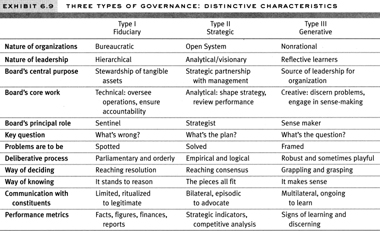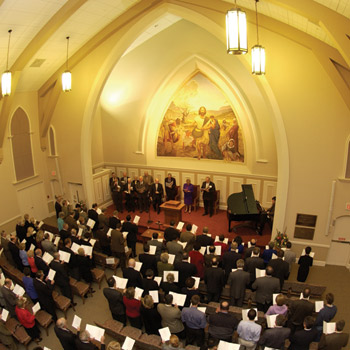Rethinking the board’s central purposes
 In Governance as Leadership, Richard Chait, William Ryan, and Barbara Taylor take two familiar concepts (governance and leadership), reframe them, and relate them in a manner that forces readers to think deeply and untraditionally about both. Our culture tends to think of both concepts individualistically — governor and leader as individual actors. The authors force us to think of both communally. Only when we are able to do that will our institutions have the capacity to utilize the multiple assets available to them and in turn become more vital.
In Governance as Leadership, Richard Chait, William Ryan, and Barbara Taylor take two familiar concepts (governance and leadership), reframe them, and relate them in a manner that forces readers to think deeply and untraditionally about both. Our culture tends to think of both concepts individualistically — governor and leader as individual actors. The authors force us to think of both communally. Only when we are able to do that will our institutions have the capacity to utilize the multiple assets available to them and in turn become more vital.
The authors remind us that our world and our institutions have become immensely more complex. No longer can a president merely be a chair of a faculty that teaches courses to readily accessible students. For trustees, governing has become more complicated and can no longer be reduced to simple aphorisms like “boards set policies and administrators implement” or “boards establish ends and management determines means.” At the same time, board work is often highly episodic, undemanding, and unsatisfying.
The authors reject the often-suggested board renewal strategies — develop a clear board structure and define the responsibilities and tasks of each board committee and member. Boards have to be engaged in meaningful, challenging, and provocative work if they are to become fully engaged and energized for their task.
Three types of governance
The authors conceive of board work and functioning in three types or modes, not tasks or structures. Two of these modes are more traditional and familiar, but it is the three operating together that transforms governance into leadership.

Pitfalls
Though each governing style is necessary, each has its downside, particularly if it is pursued alone. Fiduciary focused boards can become internally rigid and ignore the external environmental threats and opportunities impinging on the organization. The board’s work can become so prescribed and structured, attentive to the technical rather than the strategic, that board work becomes boring, unsatisfying, and unchallenging.
Strategic governance can have its own pitfalls. Planning can adopt a “blue-sky” quality, or “planning by wishful thinking,” without connecting to institutional realities and environmental challenges or opportunities. Big ideas are often generated and owned by a few who are surprised and angered when others do not rush to implement them. Many plans, worked out by countless hours of effort, approved by boards and other groups, lie gathering dust on shelves and having minimal effect on the organization and its daily efforts. In the excitement of planning, people sometimes ignore assessment and fail to recognize that a community cannot embrace a new strategic vision unless an organization’s internal culture changes first.
The problem for boards is that they usually do not engage in generative thinking, which is difficult to define and does not lend itself to job descriptions and organizational structure. In fact, this “out of the box” thinking occurs best when things are ambiguous, goals are unclear, the stakes are high, and the future is uncertain. In such a climate boards often grow uneasy and retreat to structure, accountability, and the familiar. They assume that the CEO or other administrative groups, if necessary, will do such thinking. But board behavior, rather than encouraging and supporting such creativity, may even inhibit or discourage it.
Engaging boards in generative thinking and governing is not easy, since it requires a focus on framing issues and decisions rather than making them. It sometimes necessitates suspending the rules, being playful, not holding rigidly to structure and process while promoting a new climate that encourages debating, testing, and probing. Generative thinking must be communal in nature and should not be confined either to the senior administrators or the board alone.
New questions transform a board
While reading and digesting Governance as Leadership, I kept reflecting on my two decades as a seminary president, examining what kind of board governance I encouraged and facilitated. First, I had to admit that my first few years contained a steep learning curve on board development and functioning. My first assumption was that a board is primarily a fiduciary body that also should give money. Only when we undertook our first institutional long-range planning process did the board get involved in a strategic way. Still its primary mode was to hear the plans, baptize them, and send us off to achieve them.
After a decade, a subtle but dramatic thing happened in one of our full board meetings. In the midst of a series of reports on budget, enrollment, and annual giving, a board member broke in with a question. “All of these reports I assume are important,” he said, “but I have a more fundamental question. We claim to be a church-related seminary, but are we really engaged with the church? Are our graduates really effective in ministry? Do we ever talk with our bishops and local churches? Why don’t we invite to campus the bishops and district superintendents of our surrounding conferences to talk about forming and preparing church leaders?”
There was a long silence. This set of generative questions stopped us cold in our tracks. As president I was thinking, “Oh come on, we could never get all those busy church leaders to schedule time on our campus.” Then another board member spoke up, and another, each supporting the idea and raising generative questions of their own. Energy and ideas began to flow.

Now the board was leading the seminary and the president. These generative questions and ideas kicked off a decade-long process that transformed and refocused the seminary. The leaders of the four conferences did meet on the seminary’s campus for two days, not once but in four consecutive years, to explore the issues of calling, preparing, and sustaining persons in ordained ministry. A new partnership in ministry emerged between the seminary, the annual conferences and more than a hundred partner congregations in the region.
The seminary created a new strategic plan, with board involvement at a new level, and the board became more effective in its fiduciary tasks, but not before the board, administration and faculty had reframed and generated a new understanding of the seminary, its unique mission, its primary constituency, and the its singular challenges and opportunities.
As a president I had no terms to label the dynamics of what was happening to the seminary, board, administration, and faculty. Now Governance as Leadership has given me a coherent conceptual framework to remember and understand what was happening. What a great ride it was!
The president’s role
One book cannot cover every base, but there are some areas that need more attention. The role of the president as facilitator, catalyst, manager and gatekeeper of the governance process, and “leader” of the total seminary community receives little focused attention in the book. The very governing tasks and modes the authors advocate are unlikely to emerge or function well without an administration that understands them, educates a board about them, and then encourages and facilitates the transformation.
During my years as a president, I invested a major effort in recruiting, encouraging, and involving the seminary’s board. Although I had no conceptual terms to help me understand the board’s functions, I still had a major role to play in the development and capacity building of the board. My intentions to involve the board in governance were good and rightly focused, but most of the initiative and direction of the seminary still came from the administration. Upon reflection, I realized that the board exercised its fiduciary responsibility in critical moments, some of which I had overlooked. The board also acted strategically at points, insisting on certain initiatives that I would have ignored or avoided. And they engaged in generative thinking in the pivotal way I described.
Faculty
Little is said in the book about faculty and their role in governance, which is particularly important in small, more communal institutions like seminaries. Without participation and inclusion, faculty can be roadblocks and disruptions to a governing process that is trying to transform a seminary, but when they are part of the process, the faculty are also a resource for generative thinking.
As a president, I struggled to involve faculty in the governance process as partners rather than just resident critics. I did listen well to faculty from the beginning, but that was not enough, because governance requires active participation. Only after several trials and errors did we discover a process that engaged faculty primarily at the strategic level and sometimes at the generative. A joint planning committee made up of faculty and administration, along with some board and faculty retreats, helped the faculty to engage and own an identifiable share of the seminary’s overall governance.
Governance variables
A host of other issues that influence how boards are able to govern are not specifically covered in the book. How board members are selected or appointed, how long they serve, the size of boards, their proximity or distance from campus, how often and for how long they meet, the role of church bodies and authorities, and the institution’s commitment to membership diversity all affect what is possible and the type of governance a board is able to perform. Still, these authors go to the heart of the matter — the modes and functions of governing. The significant challenges facing contemporary seminaries require our best governing and leadership. The book provides an excellent starting point and framework for all who want to perform those critical tasks well.
Related articles from the In Trust archives
Spring 2005: “Posing the Right Questions: Engage Boards Meaningfully by Tapping Into Their Collective Wisdom” by Richard P. Chait
New Year 2004: “The Board Recaptures Governance: How To Let Trustees Back into the Fun Stuff of Leadership,” a conversation with Barbara E. Taylor.
New Year 2004: “What’s the Governing Body For?: A Proposal to Repurpose the Role of Nonprofit Trustees” by William P. Ryan, Richard P. Chait, and Barbara E. Taylor.




























